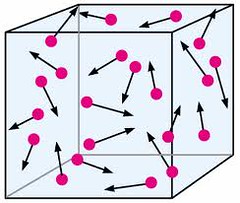Chem. Ch. 10: Physical Characteristics of Gases
1/16
Name | Mastery | Learn | Test | Matching | Spaced |
|---|
No study sessions yet.
17 Terms

What is Kinetic-Molecular Theory?
Describes the behavior of gas particles, stating that they are in constant, random motion and that the temperature of the gas is proportional to the average kinetic energy of its particles.
What is Ideal Gas?
“Imaginary Gas” that perfectly fits all the assumptions of the kinetic molecular theory.
What are the Assumptions of the Kinetic Molecular Theory
Gases are mostly empty space.
Collisions between gas particles and between particles and container walls are elastic.
Gas particles are in constant, rapid, random motion.
There are no forces of attraction or repulsion between gas particles.
The average kinetic energy of gas particles depends on the temperature of the gas.
What does it mean to have an elastic collision?
It is one in which there is no net loss of kinetic energy.
What is the Nature of Gases?
Expansion
Fluidity
Low Density
Compressibility
Diffusion
Effusion
Expansion
Due to gases having no definite shape or volume, gases expand to fill their container.
Fluidity
Gas particles glide past each other easily, and because they can gases flow, which are considered fluids.
Low Density
Gases are mostly empty space, which are 1/1000 of the density of their solid and liquid states. (1000x less dense than solids and liquids).
Compressibility
The empty space between the gas particles allows for tighter packing of the gas particles.
Diffusion
Gas particles spread out and mix with one another.
Effusion
Gas particles under pressure escape through tiny openings.
What is a Real Gas?
It is when a gas does not follow/behave according to the assumptions of the kinetic molecular theory.
What are the 4 factors that make gases act real?
Intermolecular Forces (IMF’s)
Low Temperatures
High Pressures
Finite Volume of Gas Particles (amount of gas)
What are IMF’s?
Forces of Attraction between gas atoms and/or molecules
Forces that make it possible for gas particles to stick together.
What does it mean if a gas is condensing into a liquid?
It is not behaving as an ideal gas, it is behaving like a real gas.
What are the needed for ideal gas behavior?
High temperatures and/or low pressures.
What are the needed for real gas behavior?
Low temperatures and/or high pressures.